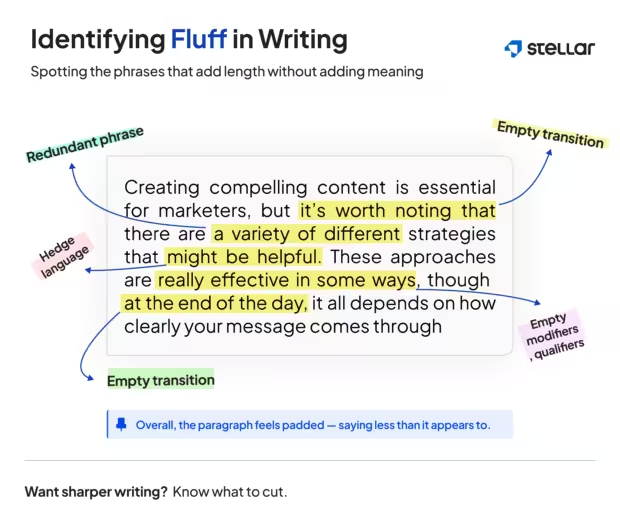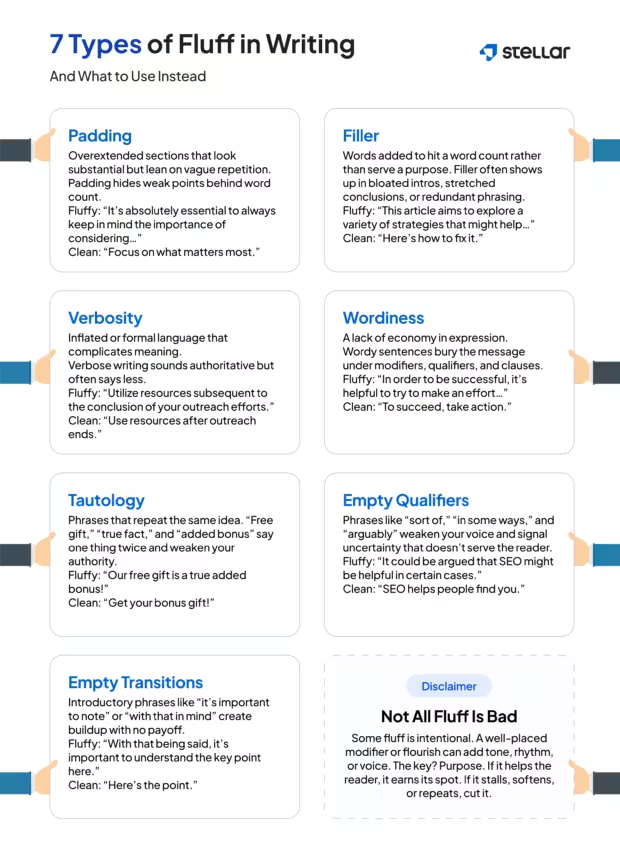
Fluff in writing refers to unnecessary language that adds length without adding meaning. Writers and editors might also call fluffy writing filler, padding, verbosity, wordiness, tautology or empty qualifiers. The result is readers spend more time parsing words and less time absorbing value.
So, why does fluff matter?
Fluff wastes space and reduces clarity.
However, clean writing doesn’t necessarily mean short. The goal is to provide comprehensive yet concise content that:
- Covers the topic deeply without going off topic or becoming repetitive.
- Delivers complete answers using just the right number of words for your audience.
That balance matters now more than ever. With AI-generated writing flooding the internet, fluff can be a sign of poorly edited or prompted LLM copy.
When search engines are evaluating content based on helpfulness and directness, fluff becomes a liability. If your writing doesn’t guide the reader forward or deliver something useful, it’s not likely to rank or convert.
While expressive language has its place in poetry, fiction and creative prose, we’re focused on fluff in functional content. Think marketing copy, thought leadership, SEO pages, blog posts and anything meant to educate, inform, persuade or convert.
In this article, we’ll break down:
- What fluff looks like in practice
- How to identify and replace it
- Actionable techniques for tightening your writing
- Why concise writing performs better in every measurable way
Let’s start by looking at the language we use to describe fluff.
What is another word for fluff in writing?
Fluff goes by many names, and each one highlights a slightly different writing weakness:
- Filler. Words added to meet a word count rather than fulfill a purpose. You’ll find filler in introductions that don’t introduce, conclusions that don’t conclude and paragraphs that say something a better sentence already said.
- Padding. Overextended sentences or sections designed to look comprehensive but built on repetition or vague elaboration. Padding often hides a weak point with word count instead of strengthening the core message.
- Verbosity. Unnecessarily formal or inflated language that obstructs clarity. Think “utilize” instead of “use” or “subsequent to the conclusion” instead of “after.” Verbose writing usually sounds authoritative — and usually isn’t.
- Wordiness. A lack of economy in expression. Wordy copy strings together modifiers, qualifiers and redundancy until the signal gets lost. It doesn’t just slow the reader down — it wastes crawl budget and ranking opportunities.
- Tautology. A phrase that repeats itself. Common offenders include “end result,” “free gift” and “added bonus.” Tautologies take up space without adding meaning and subtly erode the writer’s authority.
- Empty qualifiers. Phrases like “sort of,” “in some ways” or “arguably.” These weaken statements that should stand on their own and signal a lack of conviction. They also water down keyword clarity for search engines.
What is an example of fluff in writing?
Writers are usually told to “cut the fluff” — but that advice rarely explains what fluff actually looks like in the wild. Most of the time, it hides inside seemingly normal sentences that just happen to go nowhere. You feel it when you’re reading something and realize it could’ve been a sentence instead of a paragraph.
Here are a few tendencies that often create fluff:
- Adjective overload. If you’re stacking “innovative,” “cutting-edge,” “world-class” and “revolutionary” adjectives in front of a noun, you’re probably padding weak substance with strong-sounding air.
- Redundant phrasing. Look for pairs like “each and every,” “past history,” “true facts” or “basic fundamentals.” They say one thing twice but leave the reader knowing less.
- Hesitant hedging. Phrases like “kind of,” “in some ways,” “more or less” or “it could be argued that” signal uncertainty and slow your reader down for no good reason.
- Empty transitions. “With that being said,” “it’s important to note,” “at the end of the day” and “the fact of the matter is” — these transitions create buildup with no payoff, burning space where clarity should reign supreme.
Examples of fluff in writing
Example 1
- Fluffy text: There are a variety of different strategies that you might want to consider when you’re looking to create high-quality content that’s truly engaging and very relevant for your specific audience.
- Rewrite that eliminates fluff: Use focused, relevant strategies to create content your audience actually wants to read.
Example 2
- Fluffy text: It is generally understood that, for the most part, SEO best practices can, in many cases, help websites gain visibility in a variety of different ways on various search engines over time.
- Rewrite that eliminates fluff: SEO best practices help websites be more visible across search engines.
Example 3
- Fluffy text: When it comes to writing blog content, it’s important to really try to think about how your content might be perceived by your readers and make an effort to ensure that it actually provides value, ideally as soon as possible.
- Rewrite that eliminates fluff: Compelling blog content delivers real value to readers up-front.
These examples have the same problem: The real point is buried in soft language, stacked modifiers and roundabout phrasing. You don’t need tricks to sound smarter; you need clarity to leave the reader with zero uncertainty about your point.

How to remove fluff from writing
If you want to write content that lands with readers and ranks with search engines, clarity has to outrank cleverness, and purpose has to beat padding. Cutting fluff means writing with intention — each word working to inform, persuade or guide. Here’s how to do it, one step at a time.
1. Use active voice to clarify who’s doing what
Passive voice isn’t always wrong, but it’s rarely useful. “The strategy was developed” leaves your reader wondering by whom, why and with what authority. “Our team developed the strategy” is shorter and clearer and builds trust.
Tip: Search your draft for forms of “was,” “were” or “has been.” If they’re followed by a verb ending in -ed, you’ve probably found a passive construction that needs a rewrite.
2. Replace redundant word pairs with one sharp choice
If you’ve written “each and every,” “past history,” “free gift,” “true fact,” or “added bonus,” you’ve said the same thing twice. Your reader doesn’t need the echo. “History” implies the past. “Gift” implies free. Say it once, and move on.
3. Cut adverbs and modifiers that soften your meaning
Words like “very,” “really,” “somewhat,” “quite,” and “fairly” act like verbal training wheels. If something is important, don’t say it’s “very important.” Just say what it is — and prove it.
Try this: Remove the adverb. If the sentence still works, it was never needed.
4. Eliminate hedge language that weakens your voice
Writers often hedge when they’re unsure, especially with phrases like “I think,” “in some ways,” “can be considered,” “sort of” or “it could be said that.” These signals of self-doubt slow the reader and muddy your authority. Own your point or rewrite until you can.
Compare:
“I think SEO can be helpful for small businesses.”
→ “SEO helps small businesses build visibility.”
One is a guess. The other is a position.
5. Get to the point
Phrases like “it’s important to note,” “needless to say,” “with that in mind,” “for what it’s worth” and “the fact is,” don’t say anything. They delay the sentence that matters. Start with your point. Every paragraph should justify its place above the fold.
6. Swap long-winded constructions for cleaner phrasing
Watch for bloated setups that disguise simple ideas.
“Due to the fact that” becomes “because.”
“At this point in time” becomes “now.”
“In the event that” becomes “if.”
Every extra syllable competes for attention.
7. Split long sentences that are trying to do too much
If your sentence has three commas, a parenthetical, a dash or multiple prepositions, it’s probably doing five jobs at once. Break it into two. Readers process short sentences faster and absorb information more reliably when the pacing breathes.
Messy: In today’s competitive digital landscape, which is always evolving, businesses looking to improve their online visibility must not only focus on Google but also consider Bing, which is growing in influence.
Clean: Bing is gaining influence, and brands focused solely on Google may be missing out.
8. Use readability tools to highlight clutter
No tool replaces your brain, but tools like Hemingway and Grammarly can point to weak spots — especially after you’ve stared at the same draft for hours. Look for flagged adverbs, passive phrases, overly long sentences and passages marked “hard to read.”
9. Start with a content brief that keeps you on track
Fluff creeps in when the writer loses sight of the goal. A good strategic brief answers: Who is this for? What are they looking for? What should they walk away knowing, remembering or doing?
If your draft wanders, go back to the brief.
10. Hire writers who think while they write
Talented writers never pad to hit a word count because they care about getting the message across in the most compelling way possible. They don’t bury the lead or overuse modifiers, and they instinctively spot what can be cut before it hits the page. If you’re constantly calling out fluff, consider bringing in writers who don’t need to be told twice.
11. Work with editors who sharpen, not soften
An editor’s job is to strengthen your message. They cut vague transitions, tighten redundant phrasing, sharpen structure and spot tone drift.
12. Read your work out loud
Reading aloud is the single fastest way to catch fluff. If you can’t say the sentence without getting annoyed, losing your breath or stumbling on your own words, your reader won’t enjoy it either. Clunky phrasing, overlong clauses and unnecessary buildup all reveal themselves when spoken.

Benefits of Concise Writing
Concise writing wins because it’s more likely to get ranked, get read, and help drive conversions.
Quantity was once considered the key to visibility and performance. However, quality is proving to be the most important approach to effective content scaling.
If you want your content to perform in today’s landscape, writing with clarity and precision is paramount.
- It improves clarity and comprehension. When readers don’t have to fight through padding, they understand your message faster. That means fewer misreads, more confidence in your brand and a better experience for the exact audience you’re trying to reach.
- It strengthens your professional credibility. Verbose copy feels unsure. Sharp, informative, and helpful copy help signal authority.
- It encourages better SEO performance. Search engines prioritize usefulness and accessibility. Concise writing makes your content more scannable, headings more relevant and copy easier for bots and users to navigate. That helps support higher rankings and more visibility.
- It keeps people reading longer. Tight paragraphs and punchy transitions help keep potential customers engaged. That helps reduce the risk of high bounce rates and extends dwell time — two signals search engines care about.
- It scales better across platforms: The internet rewards clarity over word count. Concise content adapts better to mobile search, AI overviews, metadata, email previews and social — anywhere attention is short and the stakes are high.
- It makes editing faster and collaboration easier. Content that’s already tight won’t waste an editor’s time. It moves through review faster, requires fewer rewrites and creates less friction between all the players. That’s how great teams scale.
High-performance writing is concise, and in this market, performance is everything.
